Second Lebanon War: Photo Manipulation and Fraud During the Conflict
by David Krusch (Updated January 2007)
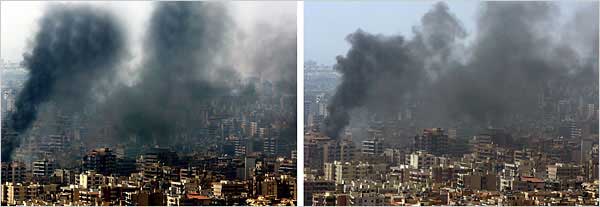 |
Reuters’ photographer Adnan Hajj doctored the photo on the left using photo editing software to show more intense smoke and destruction in Beirut. Reuters admitted to the manipulation and apologized, fired Hajj, and removed the doctored photo from its archives. The original photo appears on the right. |
Adnan Hajj, a Lebanese freelance photographer, was recently found to have doctored a photograph he took of Beirut after an Israeli airstrike on the city. After the photo ran on the Reuters news service on Saturday, August 5, Internet bloggers immediately noticed it had been manipulated with photo editing software, and created an uproar on their blogs. By Sunday, Hajj had been fired by Reuters, and his past work had been investigated for other instances of doctoring.
The blog LittleGreenFootballs.com first broke the story of the doctored photo after Charles Johnson, who runs the blog, posted the photo on the site. Johnson wrote, “This Reuters photograph shows blatant evidence of manipulation. Notice the repeating patterns in the smoke; this is almost certainly caused by using the Photoshop ‘clone’ tool to add more smoke to the image.”
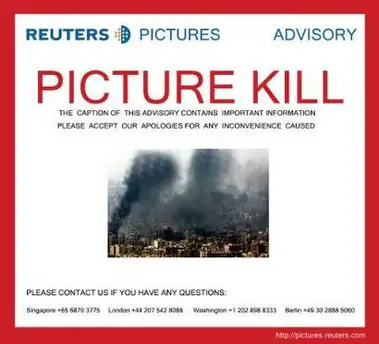 |
Reuters issued a picture kill and apologized for the doctored photo by Adnan Hajj. |
Reuters issued a picture kill and apologized for the doctored photo by Adnan Hajj On July 27, 2006, the New York Times web site ran a photo essay by Tyler Hicks depicting a rescue effort in the aftermath of an Israeli airstrike on the Lebanese city of Tyre. In this instance, the photos were not artifically manipulated, but were found to be fraudulent, and that a man that was said to have been killed in an airstrike was actually posing for camera.
A blogger on the The Gateway Pundit blog, after noticing that the final photo in the photo essay was a fraud, wrote “From the New York Times photo essay by Tyler Hicks on July 27, 2006 comes this unbelievable fraud! Dead Guy with no dust shows up with hat in photo no. 2 pointing out something to the photographer.”
After a series of complaints, the New York Times issued a correction for the photo. The correction read: “A picture caption with an audio slide show on July 27 about an Israeli attack on a building in Tyre, Lebanon, imprecisely described the situation in the picture. The man pictured, who had been seen in previous images appearing to assist with the rescue effort, was injured during that rescue effort, not during the initial attack, and was not killed.”
The correct description was this one, which appeared with that picture in the printed edition of The Times: “After an Israeli airstrike destroyed a building in Tyre, Lebanon, yesterday, one man helped another who had fallen and was hurt.”
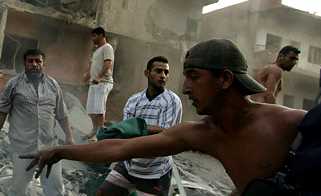 | 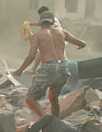 |
In one of the opening pictures of the New York Times photo essay on July 27, the man is the foreground wearing the green hat is pointing out something to the photographer. | In the next slide, the same man is seen scrambling over rubble. |
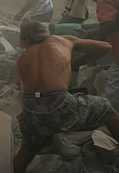 The same man is again seen in the next slide running over the debris. | 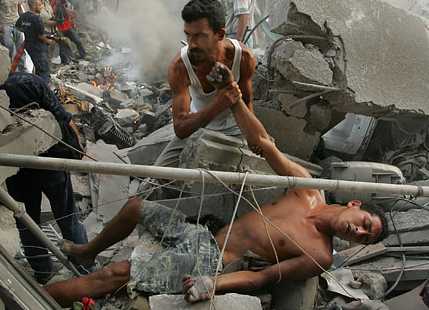 For the final picture in the photo essay, the Times wrote, “The mayor of Tyre said that in the worst hit areas, bodies were still buried under the rubble, and he appealed to the Israelis to allow government authorities time to pull them out.” However, this is the same man who had, moments earlier, been running over the rubble. Notice the green hat between his body and arm. |
Another example of misleading photography came from the cover of the July 31, 2006 edition of the U.S. News and World Report. The cover of the magazine had large photo of an armed man standing in front of a burning fire supposedly caused by Israeli airstrikes. The caption on the cover read, “A Hezbollah fighter near Beirut.” The photo implies that this fighter is standing near the scene of destruction in Beirut caused by Israeli artillery fire.
Another photo of this exact same scene also appeared on page 45 of the recent edition of Time magazine, with the caption: “The wreckage of a downed Israeli jet that was targeting Hezbollah trucks billows smoke behind a Hezbollah gunman in Kfar Chima, near Beirut. Jet fuel set the surrounding area ablaze.”
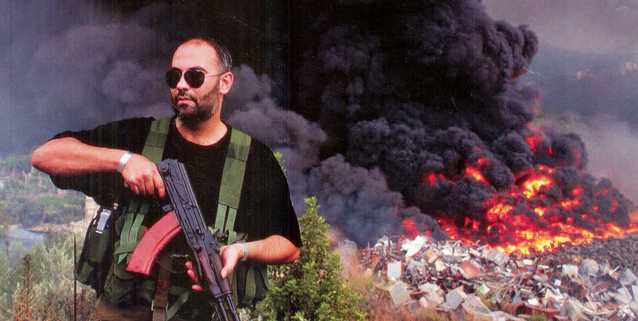 | 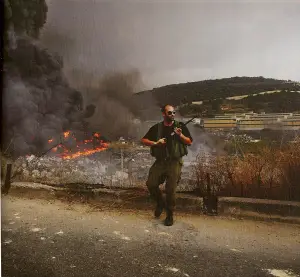 |
Photo from the cover of the July 31, 2006 edition of U.S. News and World Report depicting a Hizbullah operative supposedly standing near the scene of destruction near Beirut caused by Israeli artillery fire. | A similar photo with the same man appeared in a recent edition of Time with the caption: “The wreckage of a downed Israeli jet that was targeting Hezbollah trucks billows smoke behind a Hezbollah gunman in Kfar Chima, near Beirut. Jet fuel set the surrounding area ablaze.” |
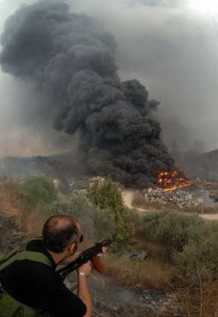 | 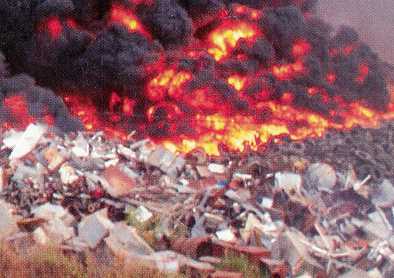 |
Another photo of the Hizbullah operative from the U.S. News and World Report taken by discredited photographer Adnan Hajj. | The fire in the photo is actually coming from the back entry and parking lot of a Lebanese army base in Kfar Chima in the eastern outskirts of Beirut. The photographer’s caption said: “Kfar Chima, near Beirute, July 17, 2006. An Israeli Air Force F16 has allegedly been shot down while bombing a group of Hezbollah owned trucks, at least one of these trucks contained a medium range ground to ground missile launcher.” |
Time subsequently issued an apology for it’s misleading caption. The photographer who took the pictures, Bruno Stevens, later explained that the caption he submitted with his photo was changed by the magazine editors. Stevens returned to the site and collected additional evidence that led him to update his caption to make it even clearer that Israel had attacked a legitimate target and that the fire had not been a result of a downed plane. He wrote, “Kfar Chima, near Beirute, July 17, 2006. The Israeli Air Force bombed a group of Hizbullah chartered trucks parked on back of large Lebanese Army barracks, at least one of these trucks contained a medium range ground to ground missile launcher, at least one missile was hit, misfiring high into the sky before falling down and starting a huge fire in the barracks parking lot.”
What made the misuse of the photos by the two publications even more egregious was the fact that they chose not to publish another Stevens photo that showed a medium-range ground-to-ground missile launcher hidden in a civilian truck on a Lebanese army base. “This is a very important piece of evidence showing probable collusion between Hizbullah and the Lebanese Army,” noted Stevens. “There is little doubt that the Lebanese Army was aware of the presence of at least one missile launcher and at least one large missile on their parking lot.....There were 6 to 8 large articulated trucks parked there, making it a very legitimate target for the Israeli Air Force, quite far away from civilian houses.”
These photographs are only a small sampling of doctored or staged pictures that have been appearing in newspapers and magazines worldwide in an attempt to show “Israeli cruelty” during its fight against Hizbullah.
Due to lack of oversight or fact checking by the editors of these publications, many of these photos have made it onto the front page of major newspapers and magazine such as the Washington Post, the The New York Times and Time. Even when these publications issue corrections for inaccurate captions or apologies for a fraudulent photograph, the public relations damage to Israel’s image has already occurred.
Sources: Katherine Q. Seelye and Julie Bosman, “Bloggers Drive Inquiry on How Altered Images Saw Print,” The New York Times, (August 9, 2006); Little Green Footballs; Yaakov Lappin, “New York Times 'used fraudulent photo,'” Ynetnews, (August 9, 2006); Michelle Malkin; Sheera Claire Frenkel, “Reuters admits doctoring Beirut photo,” The Jerusalem Post, (August 6, 2006); Reuters; “The Media Are the Enemy,” Little Green Footballs, (November 14, 2006); Bruno Stevens, “The Lebanon “garbage dump” story: complete explanation,” Lightstalkers.org


